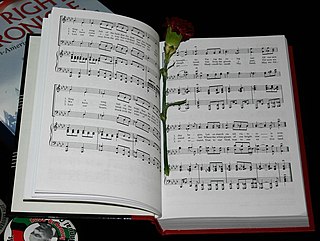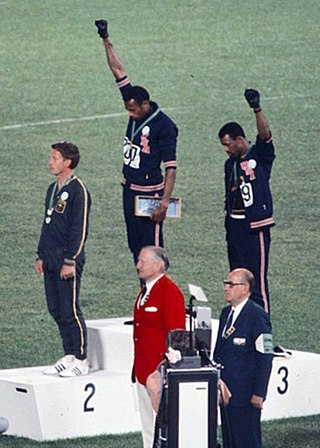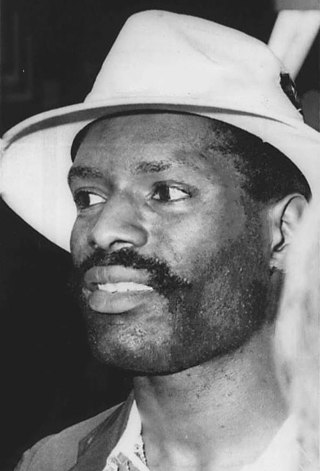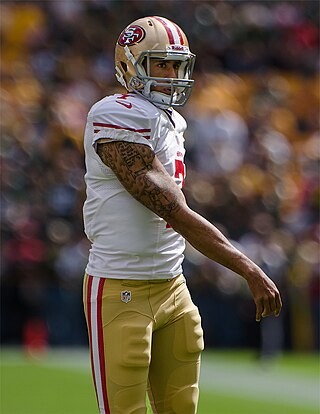
"The Star-Spangled Banner" is the national anthem of the United States. The lyrics come from the "Defence of Fort M'Henry", a poem written on September 14, 1814, by 35-year-old lawyer and amateur poet Francis Scott Key after witnessing the bombardment of Fort McHenry by British ships of the Royal Navy in Outer Baltimore Harbor in the Patapsco River during the Battle of Baltimore in the War of 1812. Key was inspired by the large U.S. flag, with 15 stars and 15 stripes, known as the Star-Spangled Banner, flying triumphantly above the fort during the U.S. victory.

"Kimigayo" is the national anthem of Japan. The lyrics are from a waka poem written by an unnamed author in the Heian period (794–1185), and the current melody was chosen in 1880, replacing an unpopular melody composed by John William Fenton in 1869. While the title "Kimigayo" is usually translated as "His Imperial Majesty's Reign", no official translation of the title or lyrics has been established in law.

"Lift Every Voice and Sing" is a hymn with lyrics by James Weldon Johnson (1871–1938) and set to music by his brother, J. Rosamond Johnson (1873–1954). Written from the context of African Americans in the late 19th century, the hymn is a prayer of thanksgiving to God as well as a prayer for faithfulness and freedom, with imagery that evokes the biblical Exodus from slavery to the freedom of the "promised land."

Mahmoud Abdul-Rauf is an American former professional basketball player. He played in the National Basketball Association (NBA) for nine years with the Denver Nuggets, Sacramento Kings and Vancouver Grizzlies.

Tommie C. Smith is an American former track and field athlete and former wide receiver in the American Football League. At the 1968 Summer Olympics, Smith, aged 24, won the 200-meter sprint finals and gold medal in 19.83 seconds – the first time the 20-second barrier was broken officially. His Black Power salute with John Carlos atop the medal podium to protest racism and injustice against African Americans in the United States caused controversy, as it was seen as politicizing the Olympic Games. It remains a symbolic moment in the history of the Black Power movement.

During their medal ceremony in the Olympic Stadium in Mexico City on October 16, 1968, two African-American athletes, Tommie Smith and John Carlos, each raised a black-gloved fist during the playing of the US national anthem, "The Star-Spangled Banner". While on the podium, Smith and Carlos, who had won gold and bronze medals respectively in the 200-meter running event of the 1968 Summer Olympics, turned to face the US flag and then kept their hands raised until the anthem had finished. In addition, Smith, Carlos, and Australian silver medalist Peter Norman all wore human-rights badges on their jackets.

Wayne Curtis Collett was an African-American Olympic sprinter. Collett won a silver medal in the 400 m at the 1972 Summer Olympics. During the medal ceremony Collett and winner Vincent Matthews talked to each other, shuffled their feet, stroked their chins and fidgeted while the US national anthem played, leading many to believe it was a Black Power protest like the 1968 Olympics Black Power salute by Tommie Smith and John Carlos.

The Olympic Project for Human Rights (OPHR) was an American organization established by sociologist Harry Edwards and multiple Black American athletes, including noted Olympic sprinters Tommie Smith and John Carlos, on October 7, 1967. The purpose of the group was to advocate for civil rights and human rights for Black people in the United States and abroad, along with protesting racism in sport in general. The OPHR proposed a complete Black athlete boycott of the 1968 Summer Olympics in Mexico City to achieve its goals. While the OPHR advocated for a boycott backed by all Black Americans, the group did not actively include women in its discussions and in the end was mostly composed of track and field athletes.

Colin Rand Kaepernick is a former American football quarterback and American civil rights activist. He played six seasons for the San Francisco 49ers in the National Football League (NFL). In 2016, he knelt during the national anthem at the start of NFL games in protest of police brutality and racial inequality in the United States.
The National Football League (NFL) was founded in 1920 as the American Professional Football Association (APFA) with ten teams from four states, all of whom existed in some form as participants of regional leagues in their respective territories. The league took on its current name in 1922. The NFL was the first professional football league to successfully establish a nationwide presence, after several decades of failed attempts. Only two founding members are still in the league, the Decatur Staleys and the Chicago Cardinals is the oldest NFL franchise.

Eric Todd Reid Jr. is an American former professional football player who was a safety in the National Football League (NFL). He played college football for LSU Tigers, receiving consensus All-American recognition. He was selected in the first round of the 2013 NFL Draft by the San Francisco 49ers, with whom he made the 2014 Pro Bowl.
The 1972 Olympics Black Power salute was a political protest by two U.S. Olympic runners, Vincent Matthews and Wayne Collett, during the medal ceremony for the Men's 400 metres at the 1972 Summer Olympics in Munich, West Germany. This event is sometimes referred to as "The Forgotten Protest". It came four years after the 1968 Olympics Black Power salute.

The Super Bowl LIII Halftime Show, officially known as the Pepsi Super Bowl LIII Halftime Show, took place on February 3, 2019, at Mercedes-Benz Stadium in Atlanta, Georgia, as part of Super Bowl LIII. It was headlined by Maroon 5, joined by rappers Big Boi and Travis Scott as guests.
The Movement for Black Lives (M4BL) is a coalition of more than 50 groups representing the interests of black communities across the United States. Members include the Black Lives Matter Network, the National Conference of Black Lawyers, and the Ella Baker Center for Human Rights. They are endorsed by groups such as Color of Change, Race Forward, Brooklyn Movement Center, PolicyLink, Million Women March Cleveland, and ONE DC, and the coalition receives communications and tactical support from an organization named Blackbird.

Beginning in August 2016, some American athletes have protested against a variety of perceived injustices in the United States by kneeling on one knee while the U.S. national anthem is played. Beginning in 2017, many players also protested against President Donald Trump's criticisms of those involved in the protest, and some against Trump's policies during his time in office. Some observers have described the protests as being politically motivated and/or patriotic and they have also praised the players' social awareness, while others have criticized the drawing of attention to social issues during sporting events, and they have also called the protests unpatriotic or disrespectful. The act itself has become widely referred to as "taking the knee" or "taking a knee".
The Syracuse Eight were 9 college football players who advocated for an end to discrimination against African American football players at Syracuse University and for other reforms to the program. They eventually boycotted a practice and then the 1969 season.

"Glory to Hong Kong" is a protest anthem that was composed and written by a musician under the pseudonym "Thomas dgx yhl", with the contribution of a group of Hongkonger netizens from the online forum LIHKG during the 2019–2020 Hong Kong protests. It was initially written in Cantonese and was eventually developed into various language versions starting with English.
On August 26, 2020, some professional athletes in the United States began to go on strike for their respective sports contests in response to the police shooting of Jacob Blake in Kenosha, Wisconsin. After the video of Blake's shooting in which he was seriously injured went viral, protests and riots broke out in the city of Kenosha and elsewhere. As a result of the shooting of Blake and the protests which followed, on August 26, professional athletes refused to play in their scheduled sports events, beginning with the Milwaukee Bucks of the National Basketball Association (NBA).

Taking the knee is a symbolic gesture against racism whereby an individual kneels upon one knee in place of standing to attention for an anthem or other such occasion. It was originated by American football player Colin Kaepernick on September 1, 2016, in protest against the lack of attention given to the issues of racial inequality and police brutality in the United States. Kaepernick's protest led to a wider series of national anthem protests. It has since been adopted by sports players in countries around the world, including association football in the United Kingdom, in solidarity with Kaepernick's protest against racism, and has been seen worldwide in non-sporting contexts such as the Black Lives Matter protests.
Athlete activism in the United States refers to using one's platform as a professional athlete to advocate for social and political issues in the United States of America. It has been an aspect of American sports culture for decades, dating back to the civil rights movement of the 1960s, with athletes such as Muhammad Ali and Tommie Smith using their fame to speak out against racism and discrimination. In recent years, athlete activism has gained renewed attention as athletes have used their platforms to address issues such as police brutality, racial inequality, and LGBTQ rights. The intersection of sports and social justice has been a contentious topic, with some praising athletes for using their influence and privilege to bring attention to important issues, while others criticize them for being too "political" or "divisive."

















